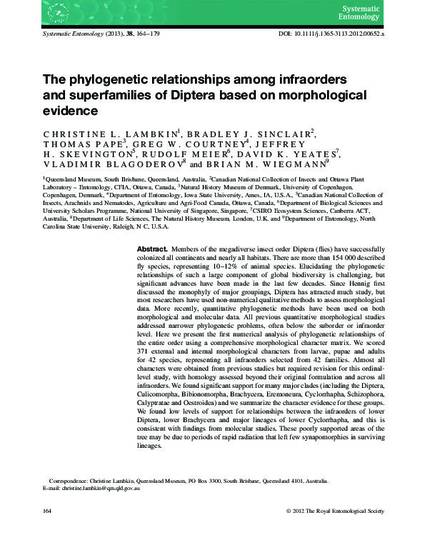
Article
The phylogenetic relationships among infraorders and superfamilies of Diptera based on morphological evidence
Systematic Entomology
(2013)
Abstract
Members of the megadiverse insect order Diptera (flies) have successfully colonized all continents and nearly all habitats. There are more than 154 000 described fly species, representing 10–12% of animal species. Elucidating the phylogenetic relationships of such a large component of global biodiversity is challenging, but significant advances have been made in the last few decades. Since Hennig first discussed the monophyly of major groupings, Diptera has attracted much study, but most researchers have used non-numerical qualitative methods to assess morphological data. More recently, quantitative phylogenetic methods have been used on both morphological and molecular data. All previous quantitative morphological studies addressed narrower phylogenetic problems, often below the suborder or infraorder level. Here we present the first numerical analysis of phylogenetic relationships of the entire order using a comprehensive morphological character matrix. We scored 371 external and internal morphological characters from larvae, pupae and adults for 42 species, representing all infraorders selected from 42 families. Almost all characters were obtained from previous studies but required revision for this ordinal- level study, with homology assessed beyond their original formulation and across all infraorders. We found significant support for many major clades (including the Diptera, Culicomorpha, Bibionomorpha, Brachycera, Eremoneura, Cyclorrhapha, Schizophora, Calyptratae and Oestroidea) and we summarize the character evidence for these groups. We found low levels of support for relationships between the infraorders of lower Diptera, lower Brachycera and major lineages of lower Cyclorrhapha, and this is consistent with findings from molecular studies. These poorly supported areas of the tree may be due to periods of rapid radiation that left few synapomorphies in surviving lineages.
Disciplines
Publication Date
2013
Citation Information
Christine L Lambkin, Bradley J. Sinclair, Thomas Pape, Gregory W. Courtney, et al.. "The phylogenetic relationships among infraorders and superfamilies of Diptera based on morphological evidence" Systematic Entomology Vol. 38 (2013) p. 164 - 179 Available at: http://works.bepress.com/gregory_courtney/15/
